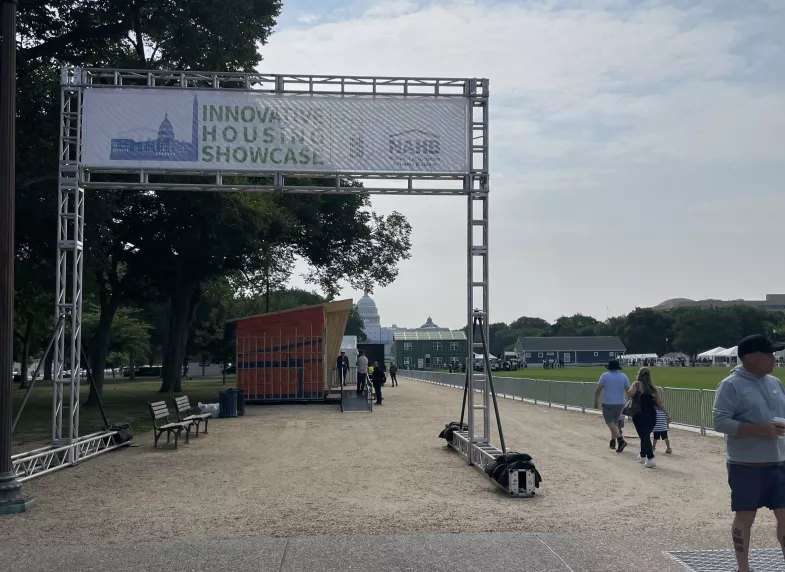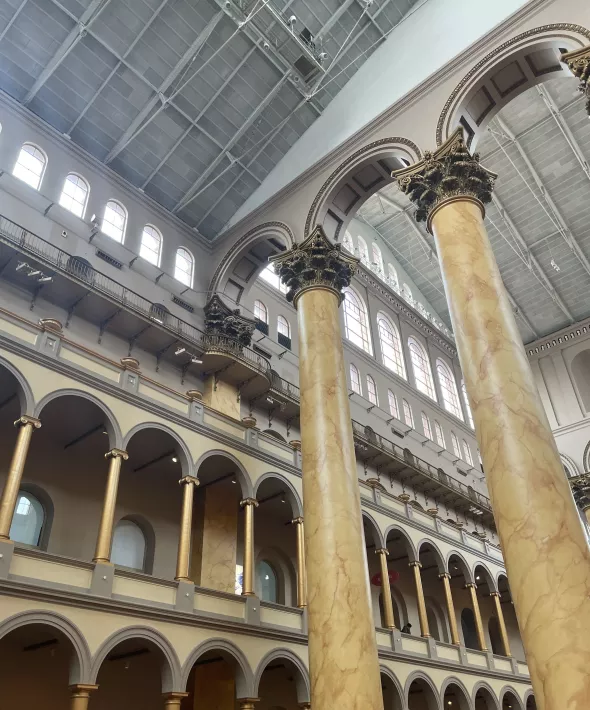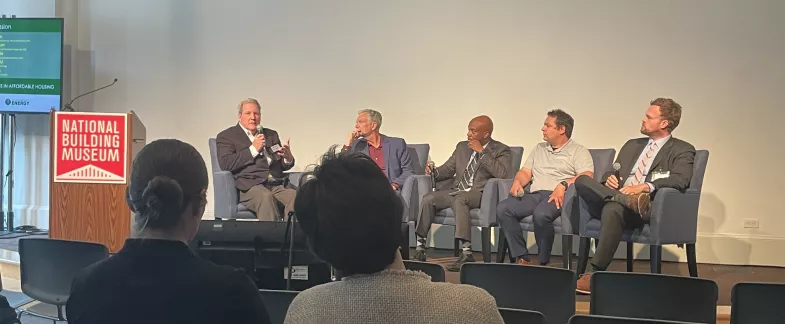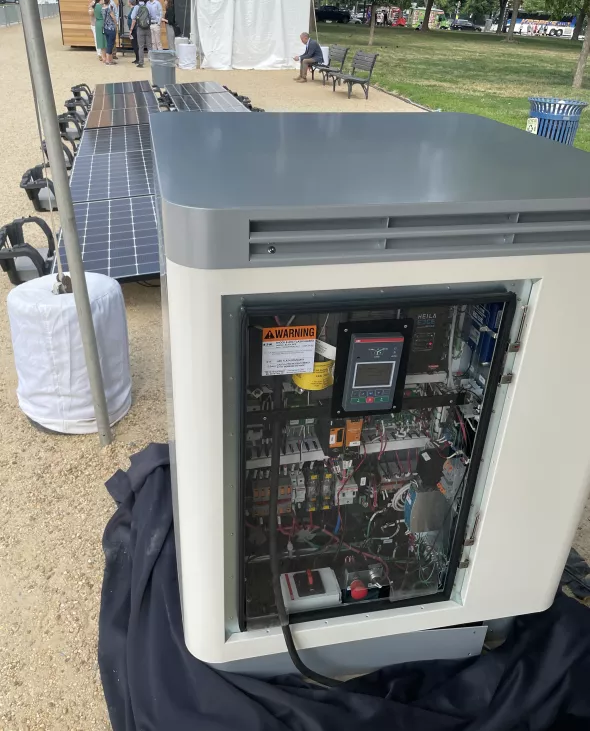Phius' Trip to the Innovative Housing Showcase in Washington, DC
Phius Associate Director Lisa White chronicles her experience at the recent Innovative Housing Showcase, where she presented and attended various sessions.
Phius Associate Director Lisa White chronicles her experience at the recent Innovative Housing Showcase, where she presented and attended various sessions.

Two weeks ago, I had the pleasure of visiting Washington, DC to speak at and attend events surrounding the weekend-long Innovative Housing Showcase, hosted by the US Department of Housing and Urban Development (HUD).
When I arrived in DC, the wildfire smoke from Eastern Canada filled the air. Being from the Midwest, wildfire smoke was new to me and that was an eye opener, to say the least. Personal face masks had resurfaced, but for a different purpose – people wore them outside, on the streets, and removed them once inside. It served as a stark reminder of the challenges we’re sure to face not only in our future, but already today. It set a tone for the events to follow. We were reminded that climate change truly has no borders.
June 8 consisted of a one-day mini conference at the National Building Museum, which came together as a collaboration between HUD, the US Department of Energy (DOE), and the EMerge Alliance.

The morning was titled “Energy Efficiency, Resilience, and Decarbonization” and was led by government representatives.
Speakers from the DOE, HUD, and US Environmental Protection Agency (EPA) opened up with a fireside chat (no pun intended, though the joke was made by a panelist – too soon). The reps from the three organizations made it known that this was the first time they had collaborated so closely, which surprised me, but hey, at least it was happening! I tried to jot down the numbers, but the biggest takeaways were that the EPA is dispersing $1 billion to retrofits through the Greenhouse Gas Reduction Fund, and 55% of that must go to low income communities and $5 billion will be provided through Climate Pollution Reduction Grants to develop and implement plans for reducing greenhouse gas (GHG) emissions and other harmful air pollutants.
A panel by the DOE followed, talking about recent developments:
The underlying question of the morning was: how do we achieve an equitable, clean, resilient future? AND quickly?! Each of these respective program leaders talked about the funding allocated to their program design and implementation. They talked about “braiding” and “layering” policies, and the forethought required to make sure the incentives could be married and create a holistic solution. How can we make sure that the electrification funding works with the whole-building upgrades to create something that is more than the sum of its parts? It reminded me of the root of passive building, where in combination, simple principles can harness not only energy savings, but comfort, resilience, affordability and more.
Despite the reality of wildfire smoke right outside the window, there was a great sense of optimism in the room. It is a time of resource abundance and we just need to figure out how to get this right. But even with money, challenges persist. But we have a shot, and we’ll get there.
The afternoon was titled “Facilitating Secure, Resilient & Equitable Clean Energy Availability in Local Housing and Communities.” The program was curated by the EMerge Alliance.
It opened with Michael Pesin, Deputy Assistant Secretary for Grid Controls and Communication from the Office of Electricity, DOE. When asked, “Do we improve the macro grid or just focus on implementing microgrids?” He said both – and we need to make sure they’re complimentary. This resonated with me. A challenge of this magnitude requires solutions at all scales and implementation levels. He pointed us to research his office has done on Microgrid Program Strategy.
Brian Patterson, Chairman and Co-Founder at the EMerge Alliance, spoke next to set the stage about the “4 D’s” – Decarbonization, Decentralization, Digitalization, and Democratization. He spoke about how the grid is changing, and the similarities between these changes and the advent of the internet.
Gary Oppendahl from BlockEnergy spoke next about their innovative utility-owned microgrid system. Their system creates resilience at the neighborhood level by distributing power generation and storage at each building site in front of the meter, feeding the home and also feeding central neighborhood loads and storage. It’s owned, operated and maintained by the utility, but the homeowners yield the resilience. One of their large installations made news during Hurricane Ian, when the community maintained power throughout a long blackout in Florida’s Gulf Coast.
David Lawrence, from Duke Energy, spoke about microgrids and nanogrid developments from a utility perspective.
I was asked to speak to bring in the passive building angle, so I presented on the great technology that every building has – the enclosure! And I explained how investments in the enclosure can unlock benefits for both decarbonization and resilience. Lowering building peak loads through enclosure upgrades creates a cascading effect on infrastructure required to operate these buildings with renewable energy, both during normal and outage operation. I presented a few neighborhood-level results from our recent work on a grant studying “Synergies Between Low-Load Buildings and Microgrids.” The full report will be released publicly very soon – stay tuned!
The afternoon closed with a few building owners and developers talking about community microgrid planning and a panel addressing challenges to deployment and implementation.


Friday, June 9 consisted of basically a huge expo floor on the national mall – with reps showcasing their innovations in housing. Some of the smaller booths were displaying new tech, or research in progress on niche subjects. A few of the bigger displays were about construction optimization, increasing speed of construction and building delivery.
And of course, there were a lot of groups attempting to create quick, affordable modular housing solutions – similar to the shipping container frenzy. Some of them claimed to be sustainable and some didn’t. With the smoke still lingering, I couldn’t help but pepper the reps with questions about air quality, filtration, etc. I didn’t see a single solution with a balanced ventilation system. It seems everyone had their own lens on health, affordability, sustainability and resilience.
The highlight for the showcase for me was connecting with the BlockEnergy team, talking about utility-owned microgrid solutions, and seeing their “BLOCKBOXTM” on display up close and personal. I think they’re onto something.
I look forward to visiting later when their system is deployed at Fairmount Heights, a 6-unit residential development just outside of DC designed to meet Phius certification. Onward and upward, until next time!